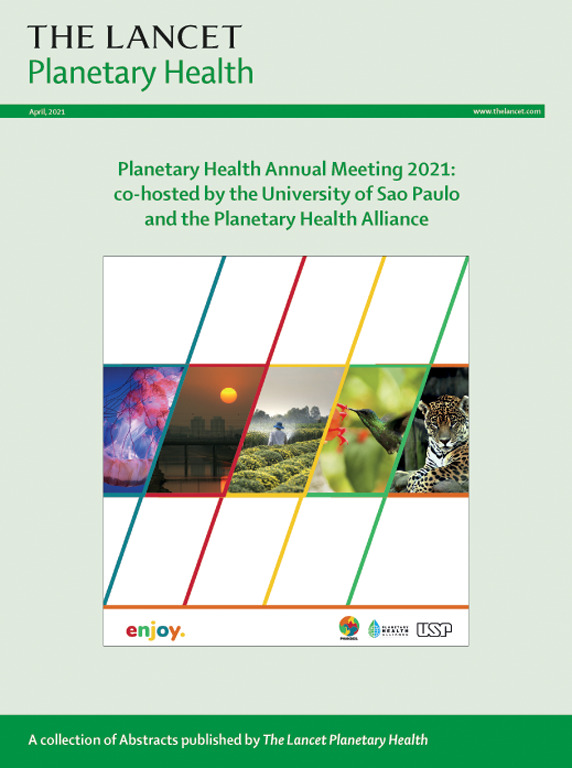Health outcomes, environmental impacts, and diet costs of adherence to the EAT-Lancet Diet in China in 1997–2015: a health and nutrition survey
IF 24.1
1区 医学
Q1 ENVIRONMENTAL SCIENCES
引用次数: 0
Abstract
Background
In 2019, the EAT-Lancet Commission proposed a global reference dietary pattern. Although research on the EAT-Lancet reference diet and its associations with mortality, cardiovascular disease, type 2 diabetes, dietary environmental impacts, and cost of diets is increasing, studies done in low-income and middle-income countries remain scarce. This study aimed to assess the health outcomes, environmental impacts, and dietary costs of adherence to the EAT-Lancet reference diet in China.
Methods
In this health and nutrition survey study, 16 029 participants from the China Health and Nutrition Survey cohort (1997–2015) were included at baseline. All-cause mortality was reported by family members and risk of cardiovascular disease and type 2 diabetes was self-reported. 3-day 24 h recall was used to assess adherence to the EAT-Lancet reference diet (Eat-Lancet Diet Index [ELDI]), diet-related environmental impacts (greenhouse-gas emissions [GHGE]), total water use (TWU), land use, and dietary costs in each survey round. Hazard ratios (HRs) for the ELDI-score were obtained by Cox models with time-varying covariates, adjusted for potential confounders. Multilevel mixed-effects linear regression was used to assess the association of environmental impacts and dietary costs to the ELDI score.
Findings
During a median follow-up of 9·86 years, 803 new cases of incident type 2 diabetes, 563 new cases of cardiovascular disease, and 908 cases of all-cause mortality were recorded. At baseline, the ELDI score ranged from 9·4 points to 110·8 points on a scale of 0 to 140, with a mean of 55·3 points (SD 11·8). With each SD increase in the ELDI score, there was an 8% decreased risk of mortality (95% CI 2·2–14·1), a 16·1% decreased risk of cardiovascular disease (9·2–20·3), and a 25·3% decreased risk of type 2 diabetes (19·5– 28·4). Each SD increase in the index was associated with a decrease of 2·2% (95% CI –2·6 to –1·8) in GHGE, 2·3% (–2·6 to –2·0) in land use, no association with TWU, but an increase in diet costs of 3·3% (2·8 to 3·8).
Interpretation
High adherence to the ELDI was associated with a lower risk of mortality, cardiovascular disease, and type 2 diabetes. However, the association with diet-related GHGE and land use was modest, and adherence was also linked to higher diet costs. The study advocates for the integration of sustainable indicators into future Chinese dietary guidelines. Additionally, policy measures such as agricultural subsidies on fruit and vegetable and carbon taxes on red meat are recommended to increase affordability, reduce environmental impact, and enhance the overall sustainability of dietary practices in China.
Funding
The China Scholarship Council and the National Natural Science Foundation of China.
1997-2015 年中国坚持 EAT-Lancet 饮食的健康结果、环境影响和饮食成本:健康与营养调查。
背景:2019年,EAT-Lancet委员会提出了一种全球参考饮食模式。尽管关于EAT-Lancet参考饮食及其与死亡率、心血管疾病、2型糖尿病、饮食环境影响和饮食成本的关系的研究正在增加,但在低收入和中等收入国家进行的研究仍然很少。本研究旨在评估在中国坚持EAT-Lancet参考饮食的健康结果、环境影响和饮食成本。方法:在这项健康与营养调查研究中,来自中国健康与营养调查队列(1997-2015)的16029名参与者作为基线。全因死亡率由家庭成员报告,心血管疾病和2型糖尿病的风险由自我报告。在每一轮调查中,采用3天24小时的召回率来评估饮食-柳叶刀参考饮食的依从性(饮食-柳叶刀饮食指数[ELDI])、饮食相关的环境影响(温室气体排放[GHGE])、总用水量(TWU)、土地利用和饮食成本。eldi评分的风险比(HRs)通过具有时变协变量的Cox模型获得,并对潜在混杂因素进行了调整。使用多水平混合效应线性回归来评估环境影响和饮食成本与ELDI评分的关系。结果:在中位9.86年的随访期间,记录了803例新发2型糖尿病病例、563例新发心血管疾病病例和908例全因死亡病例。基线时,ELDI评分在0 ~ 140分范围内为9.4 ~ 110·8分,平均为55.3分(SD 11.8)。ELDI评分每增加一个SD,死亡风险降低8% (95% CI为2.2 - 14.1),心血管疾病风险降低16.1% (95% CI为9.2 - 20.3),2型糖尿病风险降低25.3% (95% CI为19.5 - 28.4)。该指数每增加一个SD,温室气体排放减少2.2% (95% CI -2·6 ~ -1·8),土地利用减少2.3% (95% CI -2·6 ~ -2·0),与TWU无关,但饲粮成本增加3.3%(2.8 ~ 3.8)。解释:高度遵守ELDI与较低的死亡率、心血管疾病和2型糖尿病风险相关。然而,与饮食相关的温室气体排放和土地使用之间的关联并不大,坚持饮食也与较高的饮食成本有关。该研究提倡将可持续指标纳入未来的中国膳食指南。此外,建议采取政策措施,如水果和蔬菜的农业补贴和红肉的碳税,以提高可负担性,减少对环境的影响,并增强中国饮食习惯的整体可持续性。资助:中国国家留学基金委、国家自然科学基金委员会。
本文章由计算机程序翻译,如有差异,请以英文原文为准。
求助全文
约1分钟内获得全文
求助全文
来源期刊

Lancet Planetary Health
Multiple-
CiteScore
28.40
自引率
2.30%
发文量
272
审稿时长
8 weeks
期刊介绍:
The Lancet Planetary Health is a gold Open Access journal dedicated to investigating and addressing the multifaceted determinants of healthy human civilizations and their impact on natural systems. Positioned as a key player in sustainable development, the journal covers a broad, interdisciplinary scope, encompassing areas such as poverty, nutrition, gender equity, water and sanitation, energy, economic growth, industrialization, inequality, urbanization, human consumption and production, climate change, ocean health, land use, peace, and justice.
With a commitment to publishing high-quality research, comment, and correspondence, it aims to be the leading journal for sustainable development in the face of unprecedented dangers and threats.
 求助内容:
求助内容: 应助结果提醒方式:
应助结果提醒方式:


